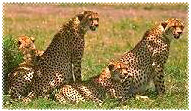Social behavior:-
 Unlike other animals which have gender specific names - 'bull' and 'cow' for elephants; 'rooster' and 'hen' for chickens - humans apply the name 'cheetah' to both sexes. Cheetah in the wild may be divided into 2 groups: the family group/females and males.
Unlike other animals which have gender specific names - 'bull' and 'cow' for elephants; 'rooster' and 'hen' for chickens - humans apply the name 'cheetah' to both sexes. Cheetah in the wild may be divided into 2 groups: the family group/females and males.Females/Family Group:-
Young females usually occupy the same range as their mother although ALL females are solitary except when they have a litter. Average female home ranges extend to 833 square kilometers (322 square miles). A female raises her cubs alone since adult male and female cheetahs mix only to mate. The average life span of wild radio-collared female cheetahs is 6.9 years which compares to 11.7 years for females in captivity.
Males:-
Only rarely will a male cheetah live alone. Generally 2 or 3 cheetah males, often brothers, will form a coalition. This small group will live and hunt together for life and usually claims a large area or range which may overlap several female territories. The average size of male territories is 37.4 square kilometers (14.4 square miles). Young males seek out an area at a great distance from their parent; sometimes as far as 482 kilometers (300 miles).
Food & Hunting:-
A cheetah is carnivorous and eats a variety of small animals. While most cats are nocturnal predators, the cheetah is primarily diurnal, hunting in early morning and late afternoon. Since it depends on sight rather than smell, it likes to scan the countryside from a tree limb or the top of a termite mound. Other big cats chase only a few hundred meters: the cheetah chases 3.4 miles (5500 meters) at an average speed of 45 miles per hour (72 kilometers per hour). Stalking is as important as the fast sprint: usually it will creep within 50 yards (46 meters) of an intended victim before the final acceleration. Full sprints last about 20 seconds and almost never exceed 1 full minute. If it succeeds in catching an animal the cheetah will suffocate it by clamping the animal's windpipe, sometimes holding a clamp as long as 5 minutes. Very small animals like hares are killed by a simple bite through the skull. But whatever the meal - large or small - cheetah eats quickly for if challenged it will most often lose. Cheetahs have unusually clean eating habits: they do not return to their kill nor do they eat carrion; they leave the skin, bones and entrails of their prey. At 6 weeks the young are strong enough to follow the hunt and when they are about 6 months old the mother will capture live prey for them to practice killing.







